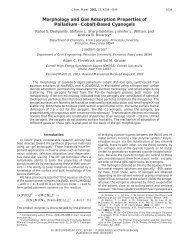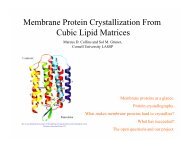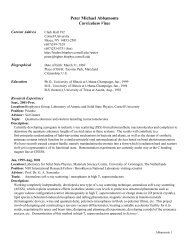Structural and Thermodynamic Characterization of T4 Lysozyme ...
Structural and Thermodynamic Characterization of T4 Lysozyme ...
Structural and Thermodynamic Characterization of T4 Lysozyme ...
You also want an ePaper? Increase the reach of your titles
YUMPU automatically turns print PDFs into web optimized ePapers that Google loves.
V149G in its folded state was the most red-shifted <strong>of</strong> all the mutants (Figure 2). It is possible that thetryptophan residue lining this polar cavity (Trp 138) reports the increased hydration <strong>of</strong> V149G.In contrast, we speculate that the enlarged hydrophobic cavity in L99G/E108V is empty at pH 3.0.The enlarged cavity <strong>of</strong> L99A is believed to be empty (1, 15), <strong>and</strong> the crystal structures <strong>of</strong> L99G/E108V<strong>and</strong> L99A are very similar except for the differing volumes <strong>of</strong> the enlarged cavities (16). At pH 3.0, themagnitude <strong>of</strong> the volume change upon pressure denaturation was roughly 50 Å 3greater forL99G/E108V compared to L99A. This value is similar to the difference in volumes <strong>of</strong> the enlargedcavities (Figure 1 (a)-(b), cavity 6) in their empty states (61.4 Å 3 ), which are the dominant contributorsto the total cavity volumes <strong>of</strong> the two mutants. This suggests that the occupancies <strong>of</strong> the two cavities aresimilar at pH 3.0. The total cavity volumes were recalculated with the new assumption that the enlargedcavity in L99G/E108V is empty <strong>and</strong> that all other crystallographically determined solvent-binding sitesare fully occupied. A correlation between denaturation volume changes <strong>and</strong> total cavity volume is nowobserved (Fig. 8 (b)). The proportionality <strong>of</strong> the two quantities suggests that all the cavities are hydratedunder pressure denaturation at this pH. The slope <strong>of</strong> the linear fits was dependent on the probe size usedto calculate the cavity volumes. Using a 1.4 Å probe gave a smaller slope as fewer small cavities couldbe detected, reducing the estimated total cavity volume <strong>of</strong> small cavity mutants by a greater fractionthan that <strong>of</strong> the large cavity mutants.The magnitude <strong>of</strong> the volume change <strong>of</strong> denaturation was also dependent on the ionic strength,reflected by the ~ 40 Å 3 change in vertical positions <strong>of</strong> linear fits in Figure 8 (b). We consider twopossible mechanisms <strong>of</strong> hydration changes around solvent-exposed residues to explain this ionicstrength dependence. At pH 3.0, <strong>T4</strong> lysozyme is highly positively charged. Most <strong>of</strong> the charged residuesare on the surface <strong>of</strong> <strong>T4</strong> lysozyme, <strong>and</strong> no change in the hydration <strong>of</strong> these residues is expected fromdenaturation. However, there are several buried <strong>and</strong> semi-buried salt bridges in <strong>T4</strong> lysozyme. Crystalstructures <strong>of</strong> <strong>T4</strong> lysozyme solved at various ionic strengths demonstrate that a change in ionic strengthdoes not affect buried salt bridges in the native state (54). These salt bridges are likely exposed in thepressure-denatured state, <strong>and</strong> the presence <strong>of</strong> counter ions around the dissociated salt pairs would reduce22









